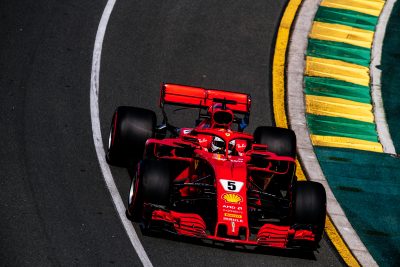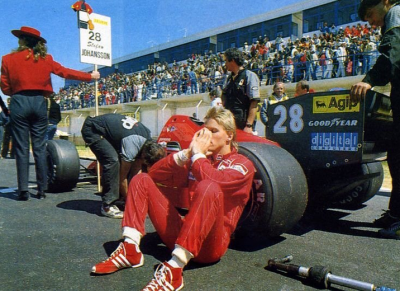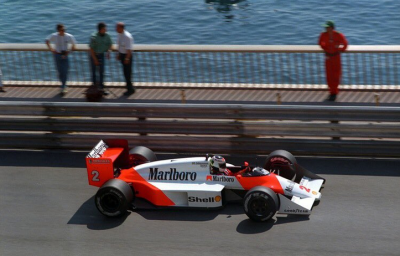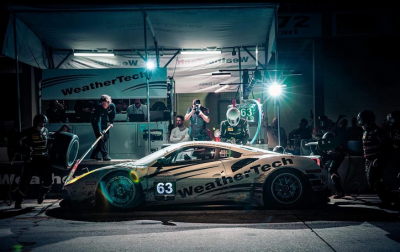
Former Formula 1 driver Stefan Johansson chats with journalist Jan Tegler about the Australian Grand Prix, Formula 1’s lack of ‘wow’ factor, the midfield battle, IndyCar’s season opener, and more
JAN TEGLER: The first grand prix of the 2018 Formula 1 season is in the books. Sebastian Vettel scored a surprise victory for Ferrari at Australian Grand Prix after a Virtual Safety Car period. Having stayed on track longer than Lewis Hamilton and team-mate Kimi Raikkonen, both of whom had already made pit stops, Vettel leap-frogged the pair by pitting under the VSC. He emerged in the lead and held it to the finish. Hamilton, who had led from the start until his pit stop, was unable to seriously challenge Vettel. Raikkonen finished 3rd.
There were just five overtakes in the race with multiple drivers complaining that they could not overtake other cars because of aerodynamic turbulence and power unit/engine overheating concerns. Fan reaction has been overwhelmingly negative following the seasons’ first contest. Red Bull racing’s Max Verstappen agreed, calling the race “Completely worthless. I would have turned off the TV.” What did you make of it?
STEFAN JOHANSSON: Yes unfortunately, it was just more of the same thing we’ve had for the last few years. And why wouldn’t it be? Nothing has really changed. The cars have even more downforce than they had in 2017 and the formula remains the same, so it’s inevitable that there will be less passing.
While the result of this race may not have shown it due to other circumstances, the worry is that Mercedes looks even stronger compared to the rest than they did last year. It seems like they’re almost back to the advantage they had in 2016.
Track position is everything now, even more than it used to be, and there’s no doubt that the Mercedes are the quickest cars. But no one, no matter how much quicker they were than the car in front, could pass. (Valtteri) Bottas for example struggled to pass even the much slower guys in front of him. It’s a real problem and anyone involved in the decision making process of the new rules should have seen this coming. Which ponders the question, how did they arrive at this solution as the final answer to whatever the problem was they were trying to fix in the first place. Was it the trade-off between faster lap time and less passing? And if so, why did faster lap times win over less passing. Or could it have been that they simply didn’t know that more downforce will produce less passing? Hard to believe, but not impossible. Unless they forgot to ask any driver who’s ever raced high downforce cars, that it becomes almost impossible to pass?
It seems incredibly obvious to me that more passing and subsequently more interesting racing to watch would have won that argument hands down, but it didn’t and here we are, with everyone now complaining about the lack of passing.
JT: The track position point you make is on target. Bearing in mind Mercedes’ performance advantage and the continuing difficulties drivers are having overtaking other cars because of turbulence, fuel-saving, and – now it appears – power unit temperature management issues, in the likely event that Mercedes qualifies up front they will just walk away from the field consistently. Do you agree?
SJ: Yes, at this point this isn’t exactly news to anyone. For several years now it’s been evident that the ever-increasing downforce just isn’t the way to go. It ruins the racing. You can get to within three or four car lengths of the guy ahead and then you’re basically stuck, no matter how quick your car is. As soon as you get any closer you lose all front grip and it’s now so bad that even when you’re within DRS range you still can’t get close enough to have a go at the end of the straight. The problem is worse in F1 than any other category because the aerodynamics are so sophisticated.
And the engine issues, well, I could never understand the logic of only being able to use three engines per season. I don’t understand what purpose this serves in the bigger picture of Formula 1 racing. I assume the original intent was to cut the costs, but as we have seen so many times before, all it did was the exact opposite, making the costs go through the roof.
When Lewis saw he couldn’t have a go at Vettel, he simply backed off to save the engine, effectively giving up trying to win the race with some laps to go. It was the right thing to do in the circumstances, but had there not been the issue of the engines having to last he could have kept pushing as hard as possible right to the end in the hope that Vettel would have made a small mistake which would have given him the chance to pounce on him with a lap or two to go. But with the risk of getting grid penalties towards the end of the season teams now have to weigh up the pros and cons of having a go, or to wait for another day. It’s hard to understand the logic behind all this at times.
It has never been more expensive than it is now for the smaller teams to buy an engine program. If there had been a simpler engine formula there would have been several companies capable of supplying a competitive engine. But with the combination of the hybrid component and the fact that the engines have to last so much longer which means the use of extremely expensive materials and subsequent development cost has made it impossible for any independent company like Cosworth, Mecachrome and several others to even contemplate to compete.
This in turn have given even more power to the big manufacturers as they now literally control the entire grid. And as history will tell you, sooner or later they will ruin every championship they compete in, as when it doesn’t serve their purpose any longer they’ll be gone, literally overnight.
We can see the start of this happening now, with the big boys starting the posturing with Liberty about the new rules, and the deals they all want going forward. It will be interesting to see how all this unravels during the course of the year.

The main priority in my opinion though, is to make sure the engineers are not involved in the decision making of the technical rules. Otherwise, nothing will change. They just want more of the same.
They need someone who really understands Formula 1, both from the FOM (Liberty) side, but more importantly also from the FIA side, someone who has a complete handle of the bigger picture and who is respected by everybody to formulate a new rules package that makes sense from a sporting, economic and technical point of view and then just say “these are the new rules, take it or leave it.”
From the Liberty side Ross Brawn is obviously the right person for this job, he seems to have assembled a great team of very competent people around him so let’s hope that the decisions they eventually come up with will take things in the right direction.
I have my doubts, however, that they will go all the way needed and it will end up being some form of a compromise as there will be pressure from the manufacturers and the FIA to stay politically correct and relevant to their agendas.
The most important aspect of all this, and I think this is where it’s often failed in the past, is that the FIA have simply not been strict enough or fast enough to enforce the rules when someone is pushing the envelope on what is allowed or not. Every one of the top teams have several people doing nothing but scan the rule book to find loopholes in the rules in order to gain an advantage.
The danger is that there will be a combined knee-jerk reaction by the FIA, the teams and Liberty. The increase of downforce for 2017 was kind of a knee-jerk reaction to the fact that the GP2 cars were nearly as quick as the F1 cars at some tracks in the previous years and they felt they had to do something to make the lap times look more respectable. The Halo was a knee-jerk reaction to the accident of Jules Bianchi.
So now the cars are several seconds per lap quicker, but who cares? It’s irrelevant because they’re only quicker mid-corner and actually a little bit slower on the straights. So the spectacle is no different, in fact it’s worse as all they’ve done is making the passing even more difficult, and the cars look more and more ugly each year because that’s what the aerodynamics dictate.
I think what is missing more than anything right now is the ‘awesome factor’. I feel that’s what’s needed more than anything in motorsport in general but particularly in F1. They need to somehow get the ‘awesome factor’ back. Right now it’s only awesome in the sense that the technology is absolutely amazing, but unless you’re a complete geek no one can appreciate it and you certainly can’t see it when the car is running.
People who aren’t die hard motorsport fans need to be able to see right away, cars that will blow them away and when they watch the racing, it should be “Wow! This is something else!”
At Indianapolis for example, you go to the 500 for the first time and you’re just blown away at the speed the cars are doing. They come by you so fast that you can’t even focus on one car easily. You have to kind of lock-in on it and follow it with your eyes as they’re all ripping by in a blur. That’s cool!
Every person I’ve taken to see the Indy 500 for the first time, including myself, are all like “Wow! That is unbelievable! Holy s**t, that is fast!”
That’s what people dig. They don’t care if a car is a few kilometres quicker in a hairpin or a chicane; no one can appreciate that, except maybe a few die-hard fans but they will show up no matter what anyway.
JT: F1 is experiencing a quantifiable decline in viewership and a palpable decline in interest from people who were once enthusiastic about it, never mind the series’ challenge in attracting new fans. As mentioned, the reaction from fans and drivers alike to the first grand prix of this new season has been overwhelmingly negative. Do you have any hope that Liberty Media and F1 will create a new formula that solves the problems we’ve discussed for several years now?
SJ: I just want to say first of all that it bothers me that we have to always sound so negative, I’m a very positive person as anyone that knows me will agree to. But unfortunately, if we are to have an open and honest dialogue about these things, it inevitably ends up this way. To answer your question, at this point no, and it worries me a great deal. No one in F1 seems to be willing to take their foot off the gas in terms of the crazy aero development war that has been going on with increasing lunacy for years now.

No one, or at least very few, care about sophisticated aerodynamics or hybrid powerplants? What’s important is good racing and spectacular looking cars, where people can visually see and appreciate the skills of the best drivers in the world giving it all they’ve got. Having all this technology constantly and needlessly applied to the cars over several years has killed the racing and sent the costs through the roof, absolutely unnecessarily. There’s no benefit to anyone from it, there’s no innovation involved, no creativity. It’s just pounding away at the same old worn out concept, gaining a tenth of a percent here or there.
Especially as there are so many different and far more relevant ways that they could achieve speed or make progress. That’s what’s so annoying. When you have road cars with more horsepower than F1 cars now, with higher top speeds, with other aspects of technology that are more advanced in many areas. F1 isn’t the ultimate anymore.
Instead it’s going down a path of political correctness that will eventually ruin the sport if it’s not careful. The key point in every one of these discussions about new rules, sporting regulations etc, should always be thinking, ‘Will this improve the racing, will this make it more exciting to watch?’ If we lose the main ingredient of why people tune in to watch, it’s difficult to make anything work from there.
JT: Speaking of looking ridiculous, there has been widespread criticism of the Halo safety device now mandatory for F1 cars.
Fans detest it and it makes identifying drivers more difficult because the Halo blocks any view of their helmets. But you did a test with CVC Simulations recently (See video below), driving a virtual F1 car with the Halo and concluded that it doesn’t hinder driver visibility. Apparently that’s correct because as yet there have been no complaints from drivers following the Australian Grand Prix.
SJ: Yes, from the driver’s point of view it’s really not a problem. The Halo does make it hard to see who’s in a car though. The drivers may as well not bother painting their helmets. They’re just not visible anymore. It’s there for a good reason of course, but I wish as time goes by they will be able to come up with a better and more aesthetically pleasing solution.
JT: Looking at the performance of the rest of the grid apart from Ferrari, you’d have to conclude that no one is even within shouting distance of Mercedes. There was improvement from some of the mid-field runners including McLaren.
Fernando Alonso finished fifth with teammate Stoffel Vandoorne coming home ninth. The Haas F1s of Kevin Magnussen and Romain Grosjean were looking very good in fourth and fifth until identical mistakes in pit lane ended their races.
Meanwhile, the mid-field standout of the last few seasons, Force India, looks to have declined the most in performance. Williams and Toro Rosso Honda are now back-markers along with Sauber Alfa Romeo. What are your thoughts on these teams?
SJ: Force India has kind of been the miracle team of the last three years, punching well above their weight each year. Teams always rotate from year to year in the midfield group. Every now and then a particular team gets it right and sometimes they themselves don’t necessarily know why they got it right. The chances that Force India would be the leader of that pack yet another year with their relatively limited resources are slim and it seems that Haas may now be in that situation this year. They definitely look like they’re the closest mid-pack team to the front runners. They were very impressive throughout the pre-season testing and again in Australia until halfway through the race when everything came apart for them. It’s looking very encouraging for them going forward, although the first three to four races are always the ‘easy’ points as everyone eventually catch up as the year goes by.
Of course, now everyone’s moaning about them being a Ferrari ‘clone’ but as I’ve said from day one of their program, so what?
If I was to start a Formula 1 team, the way Haas has done it is absolutely the way I’d go. If the rules allow it, why wouldn’t you do that instead of throwing away tens of millions of dollars on hiring people and doing your own development when you can get the same or most likely a much better solution from one of the best out there? I’m just surprised more teams aren’t doing the same thing.
Williams seems to be just continuing its downward spiral. It’s sad because they have such great history. But it doesn’t look like their performance is going to change much any time soon. Toro Rosso is struggling although I still believe that Honda will eventually get it right as long as they stay committed, and when they do I think they will be very strong. I was hoping Sauber would be the team to make the big jump this year with the Alfa Romeo connection and I’m sure increased technical support from Ferrari. Maybe it’s too soon for whatever changes they’ve made to take effect, but it doesn’t look great judging by the pre-season testing and the first race.
I think Bottas is really starting to feel the pressure now at Mercedes. And I think it emphasises again how good Nico Rosberg was. People are still reluctant to give him the credit he deserves. Lewis is clearly one of the best the sport has ever seen and for Nico to be so close to him all the time, and then to do what he did, to beat him, was impressive.
I think Bottas is in a situation now in which a lot of guys have found themselves over the years. The difference between being a really promising driver in a midfield team and a proven, top line in a top team, you never see that until a driver gets thrown in the deep end at places like Ferrari or Mercedes or Red Bull and previously, McLaren. It’s not enough to be promising when you’re in teams like that.
You can’t just have the odd great practice session or qualifying or a few great races. You have to deliver every time you step into the car, you’re expected to be right at the top of your game every session and every race. So we’ll see if Bottas can raise his game and match Lewis speed in the coming races.
JT: The IndyCar season is now underway as well with the first race, the Grand Prix of St Petersburg, having run in mid-March. It was very competitive with not only the established star drivers running quickly but a very fast group of rookies pushing them and sometimes surpassing them.
The new drivers and teams in IndyCar are creating excitement alongside the new universal aerokit and it looks like there should be a very intense, very interesting fight for the championship this season. Do you agree?
SJ: Yes it’s definitely exciting with some fresh blood and a pretty good shakeup among the ranks. Ganassi had issues with maybe not playing strategy quite right during qualifying and Team Penske wasn’t really where you’d expect them to be either all weekend. The powerhouses of the past weren’t really where you might have expected them to be, but the thing is there are really no weak teams in IndyCar anymore. They’re all pretty damn good. They’ve all improved and what you’re allowed to do to the cars with the new kit is limited, which means that any of the teams who get’s it right on the day has a chance of winning. That’s a good thing and the racing shows it. It really is a case of who can get things right on race day, which Bourdais showed again winning from way back on the grid in the Dale Coyne car.
JT: That parity among teams together with the fast crop of young drivers coming into the series is creating competitive pressure on all of the drivers. Routine decisions about qualifying, racing or passing aren’t quite as routine as they were and it’s challenging even the best drivers. You could see that at St Petersburg with the mistakes that top guys like Scott Dixon and Will Power made.
SJ: Yes, absolutely. It’s going to be a good fight as you say and the cars look like proper race cars again. I think it caught everyone a bit off guard at St. Pete how difficult and different the cars are to drive now compared to what they were. It’s definitely going in the right direction.
JT: In addition, to St Pete you were also on hand at Sebring for the 12 Hours with Scuderia Corsa. Cooper MacNeil, Alessandro Balzan and Gunnar Jeanette in the #63 Ferrari 488 GT3 had a very good race. They pushed hard to finish 2nd in the GTD class, beating some very strong competition. Unfortunately their team-mates, Townsend Bell, Bill Sweedler and Frankie Montecalvo in the #64 sister car, were out of the race early when a P2 spun in front of Montecalvo in Turn 17, leaving him nowhere to go.
What did you think of the team’s performance and the race in general?

SJ: The guys in the #63 did a great job. The accident for the #64 was a strange one and the damage was pretty significant. It was a very unfortunate thing to have happen that early on in the race. It was no fault of anyone really, just one of those bad luck situations where everything went the wrong way. There was really nothing Frankie could have done to avoid it.
The prototype battle was pretty good and the pace was quick. It was close too although the P2s seem to be behind the DPis with the BoP. The cars that came from Europe and the P2s that are in the series with the Gibson engine, they just can’t run with them.
The GTLM BoP was a bit ridiculous too. The car that hadn’t been anywhere near the front at Daytona is now the fastest all of a sudden? It’s the same old problem with BoP. There’s only ever one car or team that’s happy and they normally stand on the top of the podium, everybody else feel they’ve been screwed. There has to be a way to create a formula where you build a car, have competitive racing and may the best man win. If you want to compete, you’ve got to build a car you can compete with, period. I know some manufacturers that’s just stopped doing any form of development work as it makes no difference any more, if they go faster they just get slapped with another BoP penalty.
I’m repeating myself again, but why not un-restrict the GTLM cars and just forget the prototypes. The GT cars are so good now and their speed unrestricted would be more than sufficient even for a place like Le Mans. You’ll easily get a ten second improvement per lap the ACO keep talking about if you let the cars run to their full power potential, give them some better tires and maybe 10 percent more aero. The Ferrari 488 have nearly 300hp more in their road-car than the race car, that alone is probably worth close to six seconds around a place like Le Mans.
Put all the top drivers in them and it would be awesome. You would have just about every manufacturer of sports or supercars there and they would all have to build a road-car version of the car they compete with, that would be homologated accordingly. They would sell out that Le Mans limited edition street cars they build easily. For instance, there’s a three-year wait list for the Ford GT. They could all do the same thing. Aston Martin, Ferrari, Porsche, Audi, BMW, Lamborghini, McLaren, Corvette… they could all build a Le Mans based supercar and go for it big time. It would make a lot more sense in my opinion if any of those cars could win outright than the few prototypes that are now competing for the overall win.
Everybody would compete under the same rules, no BoP, and may the best man win.
JT: Formula E reached the halfway point of its season with the recent Punta Del Este E-Prix in Uruguay. Jean-Eric Vergne won, taking his second victory of the season and stretching his points lead in the championship over Felix Rosenqvist who took the checkers in 5th. Felix struggled with technical problems during the race, correct?
SJ: Yes, he had some problems in qualifying but he drove a good race. The sensor for the beacon which relays his energy state to the pit wall broke. So he had no idea where he was in terms of battery power consumption and he had to be very conservative.
He reckoned he could have gotten a podium finish if he had been able to attack all the way through the race and not lift and coast so much. When they got the car back in the pits after the race they looked at how much battery he had left and there was plenty left. He could have gone much harder if he had known.



















Discussion about this post